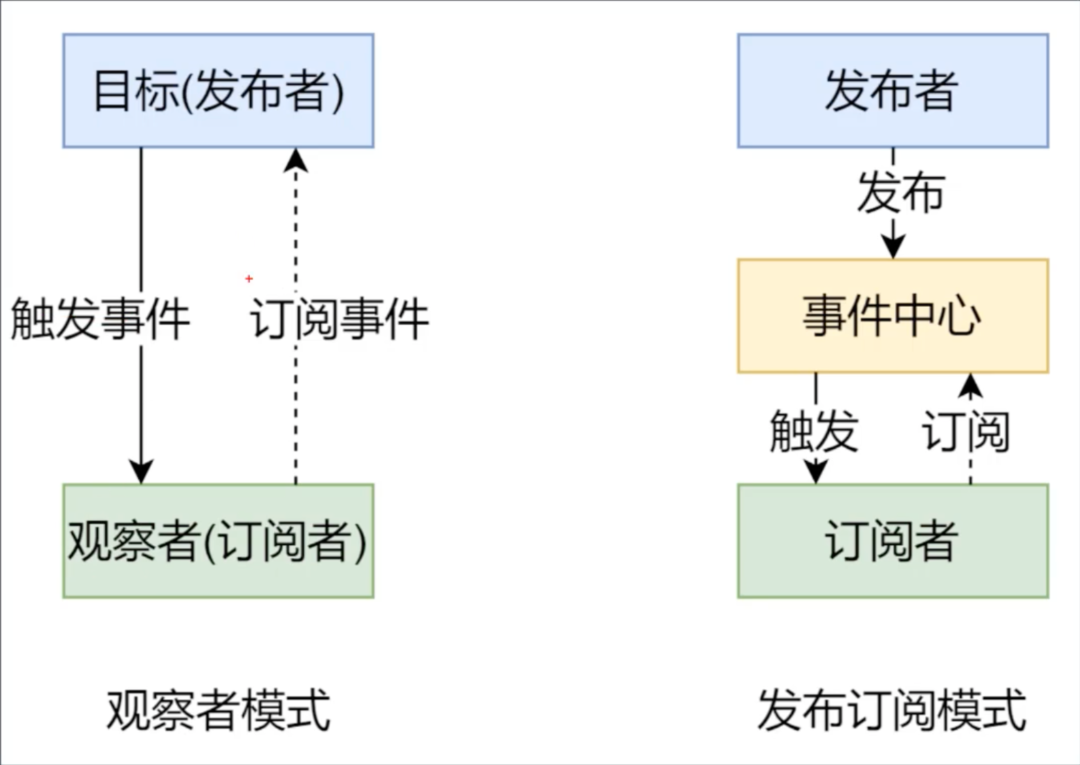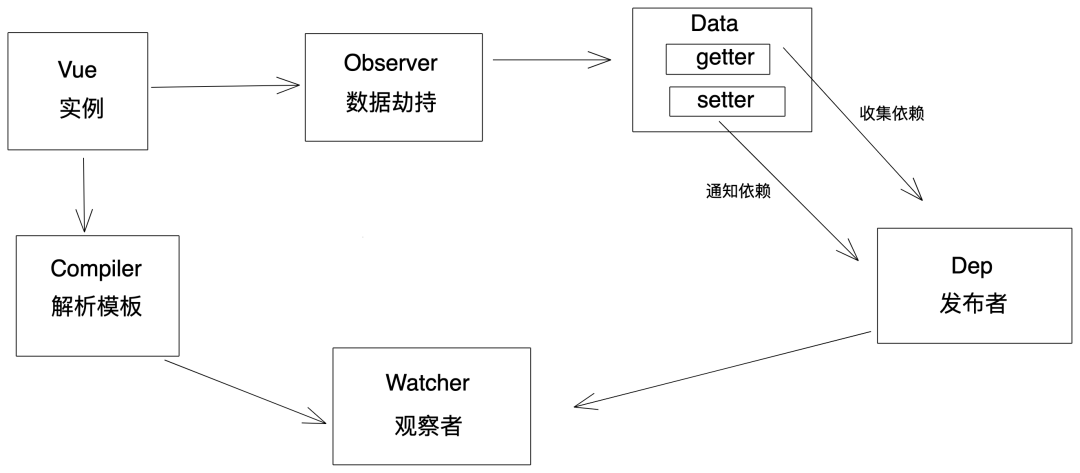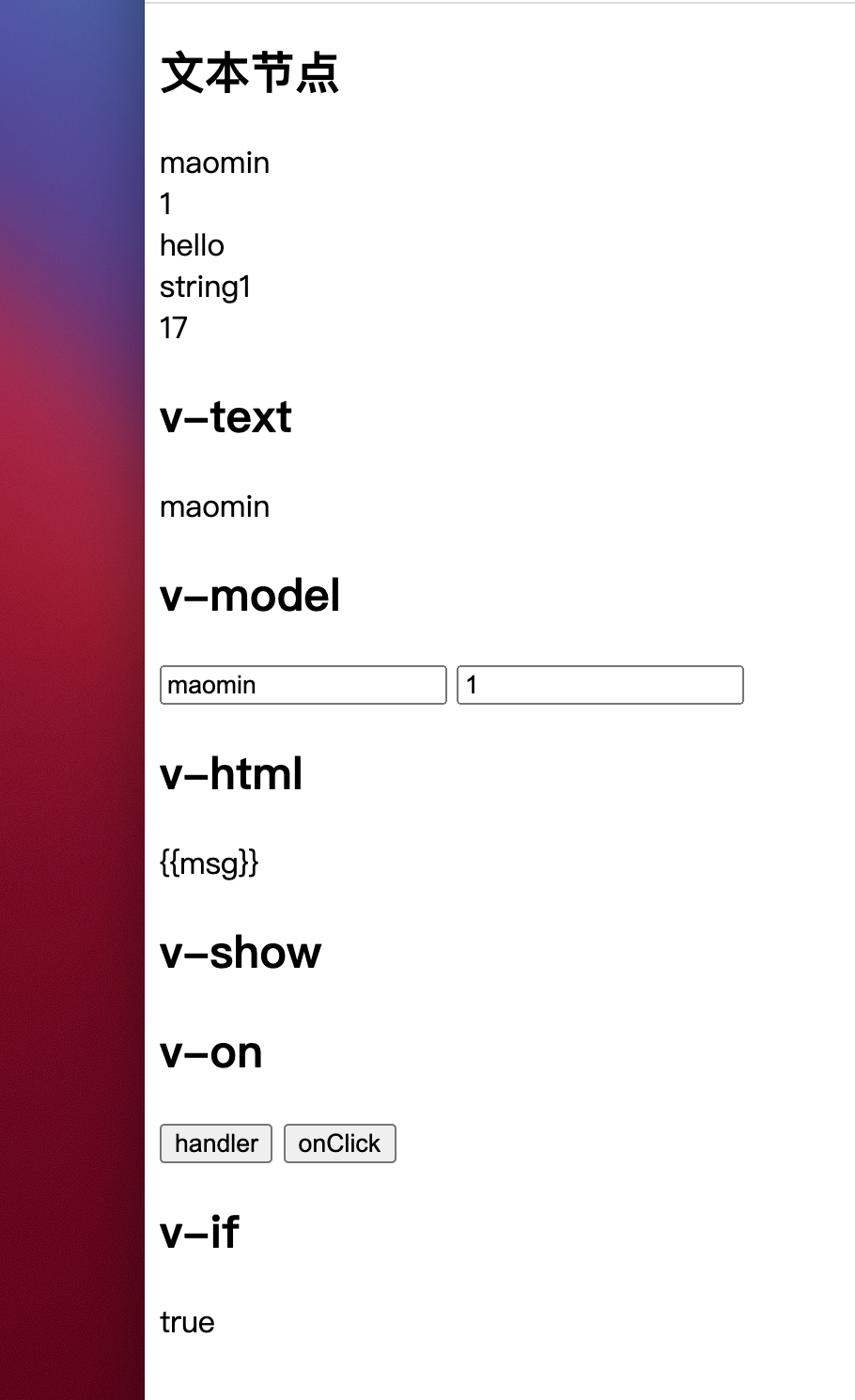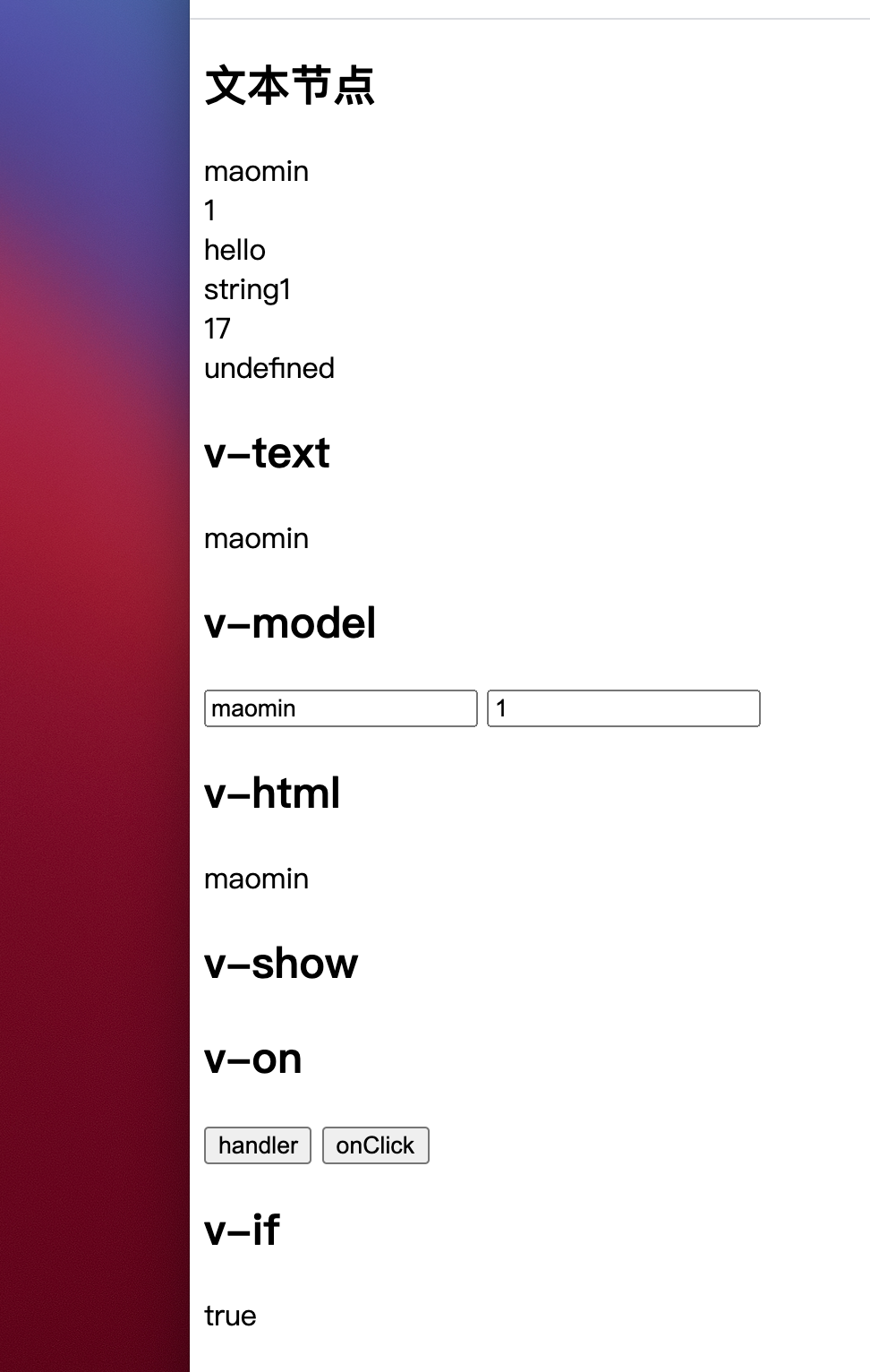浅析Vue响应系统原理与搭建Vue2.x迷你版
Vue2.x响应式原理怎么实现的?
Vue 最独特的特性之一,是其非侵入性的响应式系统。那么什么是响应式原理?
数据模型仅仅是普通的JavaScript对象,而当我们修改数据时,视图会进行更新,避免了繁琐的DOM操作,提高开发效率。简言之,在改变数据的时候,视图会跟着更新。
了解概念之后,那么它是怎么实现的呢?
其实是利用Object.defineProperty()中的getter 和setter方法和设计模式中的观察者模式。
那么,我们先来看下Object.defineProperty()。MDN中它是这样解释它的:Object.defineProperty()方法会直接在一个对象上定义一个新属性,或者修改一个对象的现有属性,并返回此对象。
let data = {
msg:'hello'
};
let vm = {};
Object.defineProperty(vm, 'msg', {
enumerable: true, // 可枚举(可遍历)
configurable: true, // 可配置(可以使用delete 删除,可以通过defineProperty重新定义)
// 当获取值的时候执行
get() {
console.log('get', data.msg);
return data.msg
},
// 当设置值的时候执行
set(newVal) {
if (newVal === data.msg) {
return
}
data.msg = newVal;
console.log('set', data.msg);
}
})
// 测试
console.log(vm.msg);
/*
> "get" "hello"
> "hello"
*/
vm.msg = 'world'; // > "set" "world"
简单介绍Object.defineProperty()之后,接着就是了解观察者模式,看到它,你可能会想起发布-订阅模式。其实它们的本质是相同的,但是也存在一定的区别。
我们不妨先来看下发布-订阅模式。
发布-订阅者模式里面包含了三个模块,发布者,订阅者和统一调度中心。这里统一调度中心相当于报刊办事大厅。发布者相当与某个杂志负责人,他来中心这注册一个的杂志,而订阅者相当于用户,我在中心订阅了这分杂志。每当发布者发布了一期杂志,办事大厅就会通知订阅者来拿新杂志。发布-订阅者模式由统一调度中心调用,因此发布者和订阅者不需要知道对方的存在。
下面,我们将通过一个实现Vue自定义事件的例子来更进一步了解发布-订阅模式。
function EventEmitter(){
// 初始化统一调度中心
this.subs = Object.create(null); // {'click':[fn1,fn2]}
}
// 注册事件
EventEmitter.prototype.$on = function (eventType,handler){
console.log(this);
this.subs[eventType]= this.subs[eventType]||[];
this.subs[eventType].push(handler);
}
// 触发事件
EventEmitter.prototype.$emit = function (eventType,data){
if(this.subs[eventType]){
this.subs[eventType].forEach(handler => {
handler(data);
});
}
}
// 测试
const em = new EventEmitter();
//订阅者
em.$on('click1',(data)=>{
console.log(data);
})
// 发布者
em.$emit('click1','maomin') //maomin
这种自定义事件广泛应用于Vue同级组件传值。
接下来,我们来介绍观察者模式。
观察者模式是由目标调度,比如当事件触发时,目标就会调用观察者的方法,所以观察者模式的订阅者(观察者)与发布者(目标)之间存在依赖。
// 发布者(目标)
function Dep(){
this.subs = [];
}
Dep.prototype.addSub = function (sub){
if(sub&&sub.update){
this.subs.push(sub);
}
}
Dep.prototype.notify = function (data){
this.subs.forEach(sub=>{
sub.update(data);
})
}
// 订阅者(观察者)
function Watcher(){}
Watcher.prototype.update=function(data){
console.log(data);
}
// 测试
let dep = new Dep();
let watcher = new Watcher();
// 收集依赖
dep.addSub(watcher);
// 发送通知
dep.notify('1');
dep.notify('2');
下图是区分两种模式。

实现Vue2.x迷你版本
为什么要实现一个Vue迷你版本,目的就是加深对Vue响应式原理以及其中一些API的理解。首先我们先来分析Vue2.x 响应式原理的整体结构。
如下图所示:

我们接下来,将根据这幅图片描述的流程来实现一款迷你版Vue。Vue2.x采用了Virtual DOM,但是因为这里只需要实现一个迷你版,所以我们这里做了简化,我们这里就是直接操作DOM。
下面,我们来看下我是如何搭建一款Vue mini的。
第一步
页面结构如下,我们可以先引入Vue2.x完整版本,看下实现效果。
<!DOCTYPE html>
<html lang="en">
<head>
<meta charset="UTF-8">
<meta http-equiv="X-UA-Compatible" content="IE=edge">
<meta name="viewport" content="width=device-width, initial-scale=1.0">
<title>Vue2.x Reactive</title>
</head>
<body>
<div id="app">
<h2>文本节点</h2>
<div>{{msg}}</div>
<div>{{count}}</div>
<div>{{obj.name}}</div>
<div>{{arr[0]}}</div>
<div>{{obj.inner.age}}</div>
<div>{{obj.inner.name}}</div>
<h2>v-text</h2>
<div v-text="msg"></div>
<h2>v-model</h2>
<input type="text" v-model="msg">
<input type="text" v-model="count">
<h2>v-html</h2>
<div v-html="html"></div>
<h2>v-show</h2>
<div v-show="isShow">{{isShow}}</div>
<h2>v-on</h2>
<button v-on:click="handler">handler</button>
<button @click="onClick">onClick</button>
<h2>v-if</h2>
<div>
<p v-if="isIf">{{isIf}}</p>
</div>
</div>
<script src="https://unpkg.com/vue@2.6.14/dist/vue.js"></script>
<script>
const vm = new Vue({
el: '#app',
data() {
return {
msg: 'maomin',
count: 1,
obj: {
name: 'hello',
inner: {
age: 17
}
},
arr: ['string1'],
html: '<div>{{msg}}</div>',
isShow: false,
isIf:true
}
},
methods: {
handler() {
// this.count = 2;
this.isIf = !this.isIf;
},
onClick() {
this.obj.inner.age = 18;
// console.log(this.obj.inner.age);
}
}
});
</script>
</body>
</html>
经过测试,Vue2.x完整版搭载的页面显示如下。我们将使用Vue迷你版本同样实现以下页面效果。

第二步
我们将根据整体结构图和页面结构来搭建这个Vue迷你版本,我们姑且将这个版本叫做vuemini.js。
通过整体结构图我们发现,一共有Vue、Observer、Compiler、Dep、Watcher这几个构造函数。我们首先创建这几个构造函数,这里不使用class类来定义是因为Vue源码大部分也使用构造函数,另外,相对也好拓展。
Vue
// 实例。
function Vue(options) {
this.$options = options || {};
this._data = typeof options.data === 'function' ? options.data() : options.data || {};
this.$el = typeof options.el === 'string' ? document.querySelector(options.el) : options.el;
// 负责把data中的属性注入到Vue实例,转换成getter/setter
this._proxyData(this._data);
this.initMethods(this, options.methods || {})
// 负责调用observer监听data中所有属性的变化
new Observer(this._data);
// 负责调用compiler解析指令/插值表达式
new Compiler(this);
}
// 将data中的属性挂载到this上
Vue.prototype._proxyData = function (data) {
Object.keys(data).forEach(key => {
Object.defineProperty(this, key, {
configurable: true,
enumerable: true,
get() {
return data[key]
},
set(newVal) {
if (newVal === data[key]) {
return
}
data[key] = newVal;
}
})
})
}
function noop(a, b, c) { }
function polyfillBind(fn, ctx) {
function boundFn(a) {
var l = arguments.length;
return l
? l > 1
? fn.apply(ctx, arguments)
: fn.call(ctx, a)
: fn.call(ctx)
}
boundFn._length = fn.length;
return boundFn
}
function nativeBind(fn, ctx) {
return fn.bind(ctx)
}
const bind = Function.prototype.bind
? nativeBind
: polyfillBind;
// 初始化methods属性
Vue.prototype.initMethods = function (vm, methods) {
for (var key in methods) {
{
if (typeof methods[key] !== 'function') {
warn(
"Method \"" + key + "\" has type \"" + (typeof methods[key]) + "\" in the component definition. " +
"Did you reference the function correctly?",
vm
);
}
}
vm[key] = typeof methods[key] !== 'function' ? noop : bind(methods[key], vm);
}
}
Observer
// 数据劫持。
// 负责把data(_data)选项中的属性转换成响应式数据。
function Observer(data) {
this.walk(data);
}
Observer.prototype.walk = function (data) {
if (!data || typeof data !== 'object') {
return
}
Object.keys(data).forEach(key => {
this.defineReactive(data, key, data[key]);
})
}
Observer.prototype.defineReactive = function (obj, key, val) {
let that = this;
// 负责收集依赖
let dep = new Dep();
// 如果val是对象,把val内部的属性转换成响应式数据
this.walk(val);
Object.defineProperty(obj, key, {
enumerable: true,
configurable: true,
get() {
// 收集依赖
Dep.target && dep.addSub(Dep.target)
return val
},
set(newVal) {
if (newVal === val) {
return
}
val = newVal;
// data内属性重新赋值后,使其转化为响应式数据。
that.walk(newVal);
// 发送通知
dep.notify();
}
})
}
Compiler
// 编译模板,解析指令/插值表达式
// 负责页面的首次渲染
// 当数据变化时重新渲染视图
function Compiler(vm) {
this.el = vm.$el;
this.vm = vm;
// 立即编译模板
this.compile(this.el);
}
// 编译模板,处理文本节点和元素节点
Compiler.prototype.compile = function (el) {
let childNodes = el.childNodes;
Array.from(childNodes).forEach(node => {
// 处理文本节点
if (this.isTextNode(node)) {
this.compileText(node);
}
// 处理元素节点
else if (this.isElementNode(node)) {
this.compileElement(node);
}
// 判断node节点,是否有子节点,如果有子节点,要递归调用compile方法
if (node.childNodes && node.childNodes.length) {
this.compile(node);
}
})
}
// 编译文本节点,处理插值表达式
Compiler.prototype.compileText = function (node) {
// console.dir(node);
let reg = /\{\{(.+?)\}\}/;
let value = node.textContent;
if (reg.test(value)) {
let key = RegExp.$1.trim();
if (this.vm.hasOwnProperty(key)) {
node.textContent = value.replace(reg, typeof this.vm[key] === 'object' ? JSON.stringify(this.vm[key]) : this.vm[key]);
// 创建watcher对象,当数据改变更新视图
new Watcher(this.vm, key, (newVal) => {
node.textContent = newVal;
})
} else {
const str = `this.vm.${key}`;
node.textContent = value.replace(reg, eval(str));
// 创建watcher对象,当数据改变更新视图
new Watcher(this.vm, key, () => {
const strw = `this.vm.${key}`;
node.textContent = value.replace(reg, eval(strw));
})
}
}
}
// 判断节点是否是文本节点
Compiler.prototype.isTextNode = function (node) {
return node.nodeType === 3;
}
// 判断节点是否是元素节点
Compiler.prototype.isElementNode = function (node) {
return node.nodeType === 1;
}
// 编译元素节点,处理指令
Compiler.prototype.compileElement = function (node) {
// console.log(node.attributes);
// 遍历所有的属性节点
Array.from(node.attributes).forEach(attr => {
let attrName = attr.name;
// console.log(attrName);
// 判断是否是指令
if (this.isDirective(attrName)) {
// 判断:如v-on:click
let eventName;
if (attrName.indexOf(':') !== -1) {
const strArr = attrName.substr(2).split(':');
attrName = strArr[0];
eventName = strArr[1];
} else if (attrName.indexOf('@') !== -1) {
eventName = attrName.substr(1);
attrName = 'on';
} else {
attrName = attrName.substr(2);
}
let key = attr.value;
this.update(node, key, attrName, eventName);
}
})
}
// 判断元素属性是否是指令
Compiler.prototype.isDirective = function (attrName) {
return attrName.startsWith('v-') || attrName.startsWith('@');
}
// 指令辅助函数
Compiler.prototype.update = function (node, key, attrName, eventName) {
let updateFn = this[attrName + 'Updater'];
updateFn && updateFn.call(this, node, this.vm[key], key, eventName);
}
// 处理v-text指令
Compiler.prototype.textUpdater = function (node, value, key) {
node.textContent = value;
new Watcher(this.vm, key, (newVal) => {
node.textContent = newVal;
})
}
// 处理v-html指令
Compiler.prototype.htmlUpdater = function (node, value, key) {
node.insertAdjacentHTML('beforeend', value);
new Watcher(this.vm, key, (newVal) => {
node.insertAdjacentHTML('beforeend', newVal);
})
}
// 处理v-show指令
Compiler.prototype.showUpdater = function (node, value, key) {
!value ? node.style.display = 'none' : node.style.display = 'block'
new Watcher(this.vm, key, (newVal) => {
!newVal ? node.style.display = 'none' : node.style.display = 'block';
})
}
// 处理v-if指令
Compiler.prototype.ifUpdater = function (node, value, key) {
const nodew = node;
const nodep = node.parentNode;
if (!value) {
node.parentNode.removeChild(node)
}
new Watcher(this.vm, key, (newVal) => {
console.log(newVal);
!newVal ? nodep.removeChild(node) : nodep.appendChild(nodew);
})
}
// 处理v-on指令
Compiler.prototype.onUpdater = function (node, value, key, eventName) {
if (eventName) {
const handler = this.vm.$options.methods[key].bind(this.vm);
node.addEventListener(eventName, handler);
}
}
// 处理v-model指令
Compiler.prototype.modelUpdater = function (node, value, key) {
node.value = value;
new Watcher(this.vm, key, (newVal) => {
node.value = newVal;
})
// 双向绑定,视图变化更新数据
node.addEventListener('input', () => {
this.vm[key] = node.value;
})
}
Dep
// 发布者。
// 收集依赖,添加所有的观察者(watcher)。通知所有的观察者。
function Dep() {
// 存储所有的观察者watcher
this.subs = [];
}
// 添加观察者
Dep.prototype.addSub = function (sub) {
if (sub && sub.update) {
this.subs.push(sub);
}
}
// 发送通知
Dep.prototype.notify = function () {
this.subs.forEach(sub => {
sub.update();
})
}
Watcher
function Watcher(vm, key, cb) {
this.vm = vm;
this.key = key;
this.cb = cb;
// 把当前watcher对象记录到Dep类的静态属性target
Dep.target = this;
if (vm.hasOwnProperty(key)) {
this.oldVal = vm[key];
} else {
const str = `vm.${key}`;
this.oldVal = eval(str);
}
Dep.target = null;
}
// 当数据发生变化的时候更新视图
Watcher.prototype.update = function () {
let newVal;
if (this.vm.hasOwnProperty(this.key)) {
newVal = this.vm[this.key];
} else {
const str = `this.vm.${this.key}`;
newVal = eval(str);
}
this.cb(newVal);
}
以上这几个构造函数就实现了我们所说的迷你版本,将它们整合成一个文件vuemini.js。在上面所提示的页面引入,查看效果。

另外,我在data中绑定了一个html属性,值为一个'<div>{{msg}}</div>',与之前完整版相比,图中的v-html下方的maomin文本也被渲染出来。
尤大开发的Vue2.x迷你版本
下面,我们将看下尤大开发的迷你版本,这个版本引入了Virtual DOM,但是主要是针对响应式式原理的,可以根据尤大的迷你版本与上面的版本作个比较,可以看下有哪些相似之处。
<!DOCTYPE html>
<html lang="en">
<head>
<meta charset="UTF-8">
<meta http-equiv="X-UA-Compatible" content="IE=edge">
<meta name="viewport" content="width=device-width, initial-scale=1.0">
<title>vue2mini</title>
</head>
<body>
<div id="app"></div>
<script>
// reactivity ---
let activeEffect
class Dep {
subscribers = new Set()
depend() {
if (activeEffect) {
this.subscribers.add(activeEffect)
}
}
notify() {
this.subscribers.forEach(effect => effect())
}
}
function watchEffect(effect) {
activeEffect = effect
effect()
activeEffect = null
}
function reactive(raw) {
// use Object.defineProperty
// 1. iterate over the existing keys
Object.keys(raw).forEach(key => {
// 2. for each key: create a corresponding dep
const dep = new Dep()
// 3. rewrite the property into getter/setter
let realValue = raw[key]
Object.defineProperty(raw, key, {
get() {
// 4. call dep methods inside getter/setter
dep.depend()
return realValue
},
set(newValue) {
realValue = newValue
dep.notify()
}
})
})
return raw
}
// vdom ---
function h(tag, props, children) {
return { tag, props, children };
}
function mount(vnode, container, anchor) {
const el = document.createElement(vnode.tag);
vnode.el = el;
// props
if (vnode.props) {
for (const key in vnode.props) {
if (key.startsWith('on')) {
el.addEventListener(key.slice(2).toLowerCase(), vnode.props[key])
} else {
el.setAttribute(key, vnode.props[key]);
}
}
}
if (vnode.children) {
if (typeof vnode.children === "string") {
el.textContent = vnode.children;
} else {
vnode.children.forEach(child => {
mount(child, el);
});
}
}
if (anchor) {
container.insertBefore(el, anchor)
} else {
container.appendChild(el);
}
}
function patch(n1, n2) {
// Implement this
// 1. check if n1 and n2 are of the same type
if (n1.tag !== n2.tag) {
// 2. if not, replace
const parent = n1.el.parentNode
const anchor = n1.el.nextSibling
parent.removeChild(n1.el)
mount(n2, parent, anchor)
return
}
const el = n2.el = n1.el
// 3. if yes
// 3.1 diff props
const oldProps = n1.props || {}
const newProps = n2.props || {}
for (const key in newProps) {
const newValue = newProps[key]
const oldValue = oldProps[key]
if (newValue !== oldValue) {
if (newValue != null) {
el.setAttribute(key, newValue)
} else {
el.removeAttribute(key)
}
}
}
for (const key in oldProps) {
if (!(key in newProps)) {
el.removeAttribute(key)
}
}
// 3.2 diff children
const oc = n1.children
const nc = n2.children
if (typeof nc === 'string') {
if (nc !== oc) {
el.textContent = nc
}
} else if (Array.isArray(nc)) {
if (Array.isArray(oc)) {
// array diff
const commonLength = Math.min(oc.length, nc.length)
for (let i = 0; i < commonLength; i++) {
patch(oc[i], nc[i])
}
if (nc.length > oc.length) {
nc.slice(oc.length).forEach(c => mount(c, el))
} else if (oc.length > nc.length) {
oc.slice(nc.length).forEach(c => {
el.removeChild(c.el)
})
}
} else {
el.innerHTML = ''
nc.forEach(c => mount(c, el))
}
}
}
// paste all previous code from Codepen
const app = {
data: reactive({
count: 0
}),
render() {
return h('div', {
onClick: () => {
app.data.count++
}
}, String(app.data.count))
}
}
function mountApp(component, selector) {
let isMounted = false
let oldTree
watchEffect(() => {
if (!isMounted) {
mount(oldTree = component.render(), document.querySelector(selector))
isMounted = true
} else {
const newTree = component.render()
patch(oldTree, newTree)
oldTree = newTree
}
})
}
mountApp(app, '#app')
</script>
</body>
</html>
关于作者
作者:Vam的金豆之路。曾获得2019年CSDN年度博客之星,CSDN博客访问量已达到数百万。掘金博客文章多次推送到首页,总访问量已达到数十万。
另外,我的公众号:前端历劫之路,公众号持续更新最新前端技术及相关技术文章。欢迎关注我的公众号,让我们一起在前端道路上历劫吧!Go!
